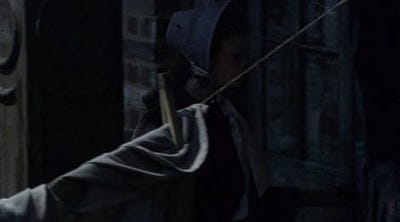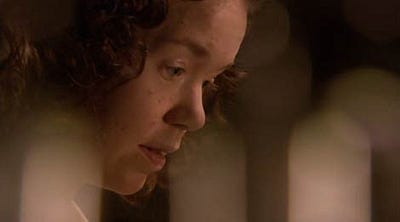Adapting Dickens, conveying London’s fog of inequality
A few thoughts occurred during the excellent TV adaptation of Bleak House recently (Ed. This piece was first published at cityofsound.com on 7 January 2006.) Many of have been voiced in Adrian Shaughnessy’s recent piece at Design Observer. As well as general praise for the series, which was hugely popular in the UK, Shaughnessy notes aspects of the production design:
“(T)he art direction brilliantly transforms London into a kind of Victorian-era Blade Runner. … Dazzling camera work makes the series feel at once dynamic and relevant by contemporary production standards, and the editing uses, to surprisingly good effect, the sorts of fashionable slam cuts more commonly found in music videos.” (Shaughnessy, Design Observer)
Personally, I’m not sure the slam cuts – and their aural accompaniment – added that much to the programme; this narrative isn’t particularly about speed, say, as a contemporaneous story of Manchester or Chicago might’ve been. I agree with everything else Shaughnessy says, though, and I also found another aspect of the camerawork interesting.
Bleak House is justifiably recognised for its magisterial beginning, and particularly its famous cloak of fog:
”Fog everywhere. Fog up the river, where it flows among green aits and meadows; fog down the river, where it rolls deified among the tiers of shipping and the waterside pollutions of a great (and dirty) city. Fog on the Essex marshes, fog on the Kentish heights. Fog creeping into the cabooses of collier-brigs; fog lying out on the yards and hovering in the rigging of great ships; fog drooping on the gunwales of barges and small boats. Fog in the eyes and throats of ancient Greenwich pensioners, wheezing by the firesides of their wards; fog in the stem and bowl of the afternoon pipe of the wrathful skipper, down in his close cabin; fog cruelly pinching the toes and fingers of his shivering little ‘prentice boy on deck. Chance people on the bridges peeping over the parapets into a nether sky of fog, with fog all round them, as if they were up in a balloon and hanging in the misty clouds.”
”Gas looming through the fog in divers places in the streets, much as the sun may, from the spongey fields, be seen to loom by husbandman and ploughboy. Most of the shops lighted two hours before their time – as the gas seems to know, for it has a haggard and unwilling look.”
”The raw afternoon is rawest, and the dense fog is densest, and the muddy streets are muddiest near that leaden-headed old obstruction, appropriate ornament for the threshold of a leaden-headed old corporation, Temple Bar. And hard by Temple Bar, in Lincoln’s Inn Hall, at the very heart of the fog, sits the Lord High Chancellor in his High Court of Chancery.”
This is both a richly descriptive ‘map’ of the city and a metaphorical device for the deadening legal process of Chancery, clearly. And such is its power and fame it was odd to see it almost entirely absent from the TV adaptation, even given the fact that it has become a clichéd symbol for Victorian London. Opening Bleak House without the fog is a little like opening A Christmas Carol in bright sunshine.
However, it could be that the unusual camerawork, for the genre, might be fulfilling the same foggy function.
In scene after scene of Andrew Davis’s adaptation, the camera obscures; framing locations such that characters were pushed to sides of the screen; filmed through doorways; shot over the shoulder of other characters; seen obscured through blurred whiskers. Candlelight and dark wood interiors, wine glasses and books, as well as the abundantly fertile paper undergrowth of legal chambers, provided numerous opportunities to crowd the actors – such that the overall effect was as oppressive as the absent fog, everyone hemmed in by circumstance and their surroundings, conveying a sense of gnawing claustrophobia.
I’ve screengrabbed a few images, almost at random, from an episode of the TV series to illustrate this: an intimate interplay between Esther and Ada awash in candlelight; a scene between an inquisitive Bucket and a deceitful Smallweed which flits from one player to the other, but never affords either character real breathing space; Vholes swimming in legal documents; Phil Squod, and various others, seen not directly but literally through their surroundings; a dinner at Bleak House observed through a doorway, then Esther and Jarndyce overheard from behind a chair; characters in street scenes glimpsed through hanging washing; Lord Dedlock speaking, but with Lady Dedlock in focus, and so on. It’s not an unusual or even particularly innovative technique but interesting to see how it served as the equivalent of even the most famous metaphors in this adaptation.











The other aspect of Bleak House I wanted to mention is the radical agenda of Dickens, discernible even at this distance, and despite much of the more obvious social commentary excised due to the need to keep a TV show going.
Even now, Dickens’s writing has a powerfully sharp critical edge to it, not least of course about all that Jarndyece & Jarndyce nonsense, but also about the conditions of the poor in Britain at that point, and particularly London. At the end of chapter 47, when little Jo dies of consumption only a few lines into a last utterance of the Lord’s Prayer, the TV adaptation has an angry and distraught Jarndyce turning away from the body, addressing no-one in particular and everyone:
”The light is come upon the dark benighted way. Dead! Dead, your Majesty. Dead, my lords and gentlemen. Dead, Right Reverends and Wrong Reverends of every order. Dead, men and women, born with Heavenly compassion in your hearts. And dying thus around us, every day.”
To interrupt the Lord’s Prayer with an unnecessary death and a dark statement on everyday death was powerful even in a BBC costume drama in 2005. Goodness only knows what the effect was in 1853.
Actually, one effect was the eventual reform of Chancery in the 1870s. Despite some sense that “Dickens had brought the poor to the attention of his middle-class readers” but only with a “distinction between the deserving and the undeserving” in tow, as noted by Paul Bailey in his review of Stephen Inwood’s book City of Cities: The Birth of Modern London, this latest adaptation reminds us to recognise the effect that Dickens had, not least because, as GK Chesterton put it: “He did what no English statesman, perhaps, has really done; he called out the people.”
All this talk of Victorian London – combined with the fact that I just read Peter Carey’s Jack Maggs – means I should also point at Jonathan Bell’s excellent piece for The Morning News before Christmas, ‘Vexed In The City’. Bell describes his ambivalent yet almost addictive relationship with London on personal terms, yet still manages to deliver some sharp insight into mapping the historical changes around him, noting that the “landscape that will never be static yet always contains some traces of the past”.
In this context, I’ll also link to the extraordinary online version of Charles Booth’s Descriptive Map of London Poverty, 1898–99 (thirty years after Bleak House), part of the excellent LSE Charles Booth archive.
We currently live amidst the red and pink codes in Booth’s map, just moments from dark blue and black of St. Giles. London is never static; and nor is its past.
Ed. This piece was first published at cityofsound.com on 7 January 2006.

Leave a comment